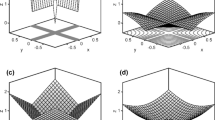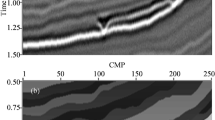Abstract
Among many seismic inversion methods, the sparse spike inversion for post-stack seismic data uses the migrated and stacked seismic data which is regarded as zero offset reflection seismic data in the case of normal incidence to extract reflectivity and impedance of underground rocks. The seismic reflectivity and impedance can reflect underground rocks’ lithology, petrophysical property, oil–gas possibility, and so forth. However, the common used post-stack seismic inversion adopts single trace in the process of inversion and completes the whole data cube’s inversion through trace by trace. It cannot use lateral regularization. Hence, the lateral continuity of single trace inversion result is poor. It is difficult to represent the lateral variation features of underground rocks. Based on the conventional sparse spike inversion, the nuclear norm of matrix in the matrix completion theory is introduced in the process of post-stack seismic inversion. At the same time, the strategy of multi-trace seismic data simultaneous inversion is used to carry out lateral regularization constraint. Numerical tests on 2D model indicate that the inversion results obtained from the proposed method can clearly represent not only the vertical variation features but also the lateral variation features of underground rocks. At last, the inversion results of real seismic data further show the feasibility and superiority of the proposed method in practical application.













Similar content being viewed by others
References
Aki K, Richards PG (2002) Quantitative seismology, 2nd edn. University Science Books, Mill Valley
Bai Y, Yang C, Jing X (2002) The geology-constrained wave impedance inversion. GeophysProspec Pet 41:61–64 (in Chinese with English abstract)
Berteussen KA, Ursin B (1983) Approximate computation from seismic data. Geophysics 48:1351–1358
Cooke DA, Schneider WA (1983) Generalized linear inversion of reflections seismic data. Geophysics 48:665–676
Dai RH, Yin C, Liu Y, Zhang XD, Zhao H, Yan K, Zhang W (2019) Estimation of generalized Stein’s unbiased risk and selection of the regularization parameter in geophysical inversion problems. Chin J Geophys (Chin) 62:982–992 (in Chinese with English abstract)
Dai R, Yin C, Yang S, Zhang F (2018) Seismic deconvolution and inversion with erratic data. Geophys Prospect 66:1684–1701
Dai R, Zhang F, Liu H (2016) Seismic inversion based on proximal objective function optimization algorithm. Geophysics 81:R237–R246
Davis G, Mallat S, Avellaneda M (1997) Adaptive greedy approximations. Constructive Approximation 13:57–98
Donoho D, Maleki A, Montanari A (2009) Message passing algorithm for compressed sensing. ProcNatlAcadSci USA 106:18914–18919
Donoho D, Maleki A, Montanari A (2010) Message passing algorithm for compressed sensing II: analysis and validation. In: Proceedings of the IEEE Information Theory Workship, pp 1–5.
Elad M (2009) Sparse and redundant representations: from theory to applications in signal and image processing. Springer, Berlin
Gholami A (2015) Nonlinear multichannel impedance inversion by total-variation regularization. Geophysics 80:R217–R224
Gholami A, Sacchi MD (2012) A fast and automatic sparse deconvolution in the presence of outliers. IEEE Trans Geosci Remote Sens 50:4105–4116
Hamid H, Pidlisecky A (2015) Multitrace impedance inversion with lateral constraints. Geophysics 80:M101–M111
JamaliHondori E, Mikada H, Goto T, Takekawa J, (2013) A random layer-stripping method for seismic reflectivity inversion. ExplorGeophys 44:70–76
Keshavan RH, Montanari A, Oh S (2010) Matrix completion from a few entries. IEEE Trans Inf Theory 56:2980–2998
Ma J (2013) Three-dimensional irregular seismic data reconstruction via low-rank matrix completion. Geophysics 78:V181–V192
Mallat SG, Zhang Z (1993) Matching pursuits with time-frequency dictionaries. IEEE Trans Signal Process 41:3397–3415
Menke W (1984) Geophysical data analysis: Discrete inverse theory. Academic Press, Inc, Cambridge
Natarajan BK (1995) Sparse approximate solutions to linear systems. SIAM J Comput 24:227–234
Recht B, Fazel M, Parrilo PA (2010) Guaranteed minimum-rank solutions of linear matrix equations via nuclear norm minimization. SIAM Rev 52:471–501
Robinson EA, Treitel S (1980) Geophysical Signal Analysis. Prentice-Hall, Upper Saddle River
Wang Y, Yang J, Yin W, Zhang Y (2008) A new alternating minimization algorithm for total variation image reconstruction. SIAM J Imaging Sci. 1:248–272
Xu L, Lu C, Xu Y, Jia J (2011) Image smoothing via L0 gradient minimization. ACM Trans Graph 30:6 (Article 174)
Yin X, Liu X, Wu G, Zong Z (2016) Basis pursuit inversion method under model constraint. Geophys Prospect Pet 55:115–122 (in Chinese with English abstract)
Zhang F, Dai R, Liu H (2014) Seismic inversion based on L1-norm misfit function and total variation regularization. J ApplGeophys 109:111–118
Zhang H, He Q (1995) Broad-band constrained inversion. Geophys Prospect Pet 34:1–10 (in Chinese with English abstract)
Zhou Z, He J, Zhao H (1998) Solving a seismic trace inversion problem by using generalized conjugate gradient algorithm. Oil Geophys Prospect 33:439–447 (in Chinese with English abstract)
Zhang F, Liu H, Niu X, Dai R (2014) High resolution seismic inversion by convolutional neural network. Oil Geophys Prospect 49:1165–1169 (in Chinese with English abstract)
Zhang Y, Luo Y, Ling F (2001) Seismic trace multi-scale inversion using logging data and seismic data. Earth Sci J Chin UnivGeosci 26:533–537 (in Chinese with English abstract)
Acknowledgements
We are grateful to the reviewers for their constructive comments on this paper. This research is supported by the following funds: the National Natural Science Foundation of China (No. 41874146), the National Science and Technology Major Project (No. 2016ZX05024001-003), and the Initiative Projects for Ph.D. in China West Normal University (No. 19E063).
Author information
Authors and Affiliations
Corresponding author
Appendix: AMP algorithm
Appendix: AMP algorithm
The specific procedures of AMP algorithm are the follows.
-
(A)
Initialize R0 = Rinitial, Z0 = K, k = 0, regularization parameters μ and ρ, initial threshold value η and initial shrinkage parameter υ [one can reference Ma (2013) for selection of initial threshold value η and initial shrinkage parameter υ], auxiliary parameter β;
-
(B)
While the following stopping criterion is not satisfied, do outer iteration,
$$\frac{{||{\mathbf{K}} - {\mathbf{LR}}_{k} ||_{F}^{2} }}{{||{\mathbf{K}}||_{F}^{2} }} < \varepsilon_{1} ,$$(38)where, ε1 is outer iteration tolerance value. If not, stop outer iteration and output iteration result;
Outer iteration procedure,
-
(a)
While the following stopping criterion is not satisfied, do inner iteration,
$${||}{\mathbf{R}}_{k} - {\mathbf{R}}_{k + 1} {||}_{F}^{2} < \varepsilon_{2} ,$$(39)where, \(\varepsilon_{2}\) is inner iteration tolerance value. If not, stop inner iteration and turn to step b;
-
(b)
Decrease threshold value and inner iteration tolerance value, i.e.,
$$\eta = 0.8\eta ,$$(40)$$\varepsilon_{2} = \frac{{\varepsilon_{2} }}{3},$$(41)and repeat outer iteration;
-
(1)
Calculate
$${\mathbf{R}}_{k + 1}^{{{\text{temp}}}} = {\mathbf{R}}_{k} + \frac{1}{\mu }{\mathbf{L}}^{{\text{T}}} {\mathbf{Z}}_{k} .$$(42) -
(2)
Perform SVD (singular value decomposition) on\({\mathbf{R}}_{k + 1}^{{{\text{temp}}}}\), and get
$${\mathbf{R}}_{k + 1}^{{{\text{temp}}}} = {\mathbf{U\Lambda V}}^{{\text{T}}} .$$(43) -
(3)
Perform soft threshold shrinkage on singular values of \({\mathbf{R}}_{k + 1}^{{{\text{temp}}}}\), i.e.,
$$\Lambda_{\tau } { = }S_{\tau } ({{\varvec{\Lambda}}}),$$(44)where, \(\tau = \frac{\eta }{\mu }\);
-
(4)
Calculate
$${\mathbf{R}}_{k + 1} = {\mathbf{U}}{{\varvec{\Lambda}}}_{\tau } {\mathbf{V}}^{{\text{T}}} .$$(45) -
(5)
Set
$$\upsilon = \upsilon (1 - k/K),$$(46)where, K is pre-set maximum number of iterations for AMP algorithm;
-
(6)
Calculate
$${\mathbf{Z}}_{k + 1} = {\mathbf{K}} - {\mathbf{LR}}_{k + 1} + \upsilon {\mathbf{Z}}_{k} .$$(47) -
(7)
Set k = k + 1, and repeat inner iteration.
-
(a)
Rights and permissions
About this article
Cite this article
Dai, R., Zhang, F., Yin, C. et al. Multi-trace post-stack seismic data sparse inversion with nuclear norm constraint. Acta Geophys. 69, 53–64 (2021). https://doi.org/10.1007/s11600-020-00506-0
Received:
Accepted:
Published:
Issue Date:
DOI: https://doi.org/10.1007/s11600-020-00506-0




